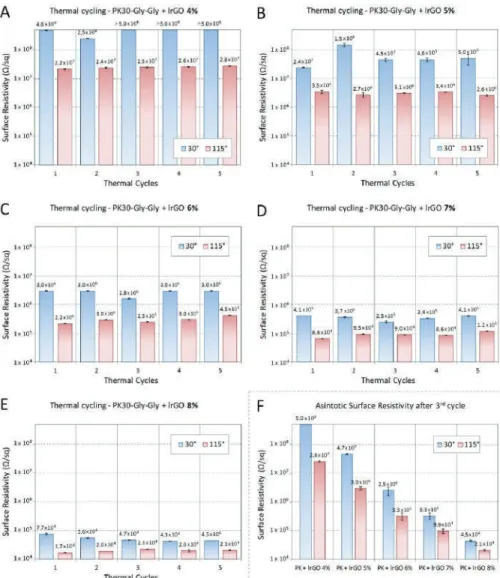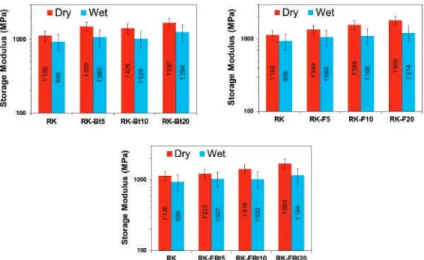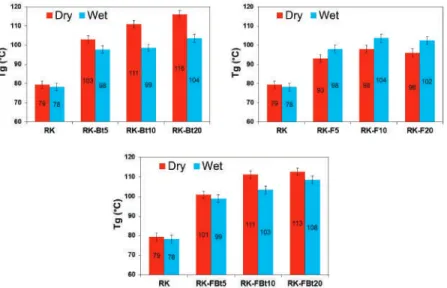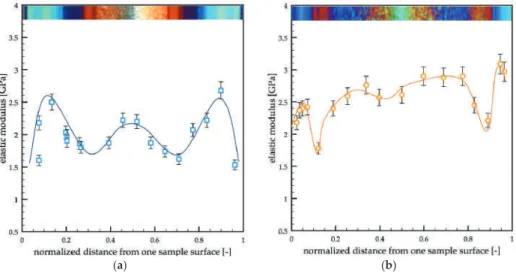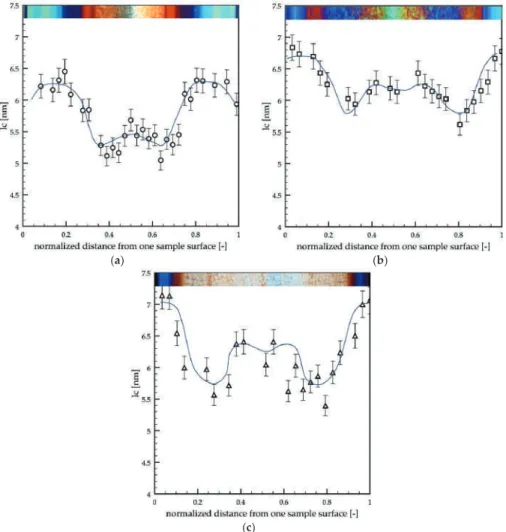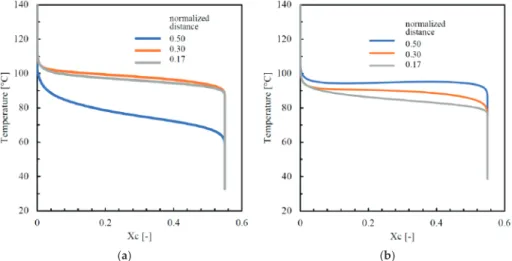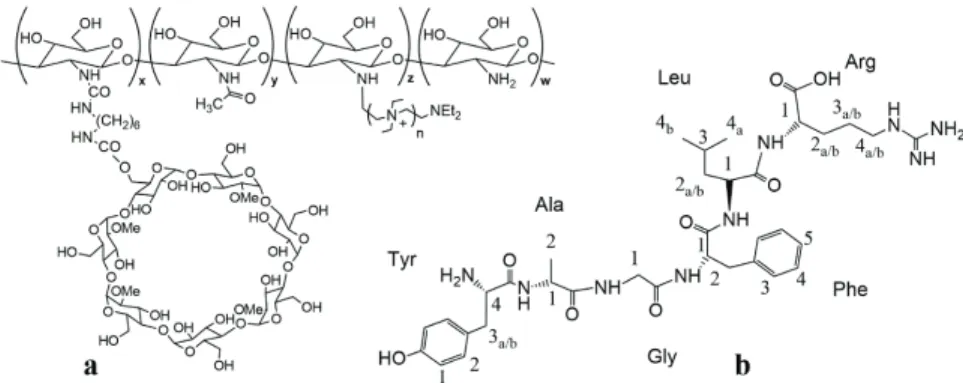The mechanical properties of the samples were tested using a dynamic mechanical analyzer (DMA 2980, TA Instruments, New Castle, DE, USA). The effect of moisture on the thermomechanical properties of the sample can be seen in Figure 7 (wet samples).

Conclusions
Effect of layered double hydroxide integrated with fluoride ions on the physical, biological and release properties of a dental composite resin. Inhibition of proton-translocating ATPases from Streptococcus mutans and Lactobacillus casei by fluoride and aluminum. Arch.
Effect of Rapid Mold Heating on the Structure and Performance of Injection-Molded Polypropylene
- Introduction
- Materials and Methods 1. Injection Molding Test
- Results
- Elastic Modulus Distributions
- Discussion
- Conclusions
In addition, they were characterized by higher elastic modulus values relative to the passive sample. Sample B showed the lowest values of elongation along the whole thickness according to the increase of the surface temperature of the cavity and the duration of the heating.

Improvement of Peptide Affinity and Stability by Complexing to Cyclodextrin-Grafted
Ammonium Chitosan
Materials and Methods
Based on knowledge of the cyclodextrin content of the conjugated polymer, an N+-rCh-MCD concentration of 3.60 mg/mL (corresponding to 2.50 mg of polymer in the NMR tube) was chosen to establish the grafted MCD 1:1. The molar ratio /DAL. Then, sample solutions (0.5 mL), all containing 50 μg/mL DAL, were applied to the apical side of each of the transpus inserts.
Results and Discussion 1. NMR Characterization
The standard deviation (SD) and coefficient of determination (R2) of the linear regression are also shown. The DAL/MCD mixture was used as a model for investigating the nature of the interaction of DAL with MCD.

Epoxy-Based Hybrid Formulations: Properties and Durability Performance
Experimental
In Scheme 2 the main steps followed for the production of the hybrids of this study are illustrated. For the production of the Hybrid DGEBA, Hyb-L-A and Hyb-L-B systems, the bisphenolic resin was functionalized with bis-(γ-propyltrimethoxysilane) amine, commercially known as NPTEOS and purchased by Aldrich (purity>90%). The unmodified or modified curatives constituted Part B of the hybrid systems, as well as for the control formulations.
The nominal SiO2 contents in cold-cured epoxy-siloxane hybrids are summarized in Table 1. The effect of shorter curing times was also evaluated on some manufactured systems.
Results and Discussion
However, the high Tgo obtained in the Hyb-L-B system can be partly attributed to the stiffness of the aliphatic ring in the PACM molecule [23]. It should be noted that the Tg was in the plateau phase of the cure during curing (see Fig. 1b). The results of DMTA testing performed on representative hybrid systems of the current work are shown in Figure 5.
The tests revealed a peculiar behavior of the hybrid systems during aging in a moisture/water environment. The inset shows the derivative of the TGA curves obtained for the same systems.

Patent
The study also examined the effects of various amine hardeners as well as the use of a typical accelerator (M851), ammonium molybdate and a deep eutectic solvent. Ongoing studies are investigating the possibility of using such cold-cured epoxy-silica hybrids in conjunction with precured fiber-reinforced composites or other carbon fiber-based products suitable for retrofitting structural engineering applications. Variable Analysis in Gelation of Alkoxysilane Solutions for the Preparation of Polyimide-Silica Hybrids. Mater.
Features in the structure-properties relationship of epoxy-silica hybrids with highly organic siloxane domains. Polymer. Cold-cured epoxy-silica hybrids: Effects of large variation in sample thickness on the evolution of Tgand-related properties. Polym.
Ionic Liquid as Dispersing Agent of LDH-Carbon Nanotubes into a Biodegradable Vinyl
Alcohol Polymer
Materials and Methods 1. Materials
Figure 2 shows the TGA curves of the LDH in nitrate form, the CNTs and the hybrid LDH-CNTs. For the LDH-NO3, the band around 3600 cm−1 is attributed to stretching of the –OH bond of the. The weak band at 1630 cm−1 can be assigned to the H2O bending vibration of the intervening water.
We also measured the electrical conductivity of the sample based on HAVOH and 3% LDH-CNT without IL. The structural characterization and analysis of the physical properties of the obtained composites was carried out and compared with the unfilled polymer.

Synthesis and Characterization of High-Performing Sulfur-Free Tannin Foams
The pH value of the solution was measured with a WTW inoLab pH 720 m (Xylem, New York, NY, USA). Figure 1 shows the different appearance of standard (SA-DE) and petroleum ether (NA-PE) foam. Figure 2 shows the structure of the cell wall for the standard foam (SA-DE), for that without sulfur (NA-DE) and for that produced with an aliphatic blowing agent (SA-Pent).
In the foams catalyzed by nitric acid, a significant increase in the intensity of the bands between: (i) 1480 and 1220 cm−1 and (ii) 1150 and 1050 cm−1 is recorded; both of these regions are dominated by the absorption of phenolic components [31]. The graph shows the mass loss of foams during the combustion and ignition phase.

Comparative Investigation on the Soil Burial Degradation Behaviour of Polymer Films for
Figure 1 highlights that the photo-oxidation affects the elongation at break of the two biodegradable polymers much more than that of the PE-based film samples. Figure 3 shows the mean weight losses of the virgin and photooxidized samples vs. On the contrary, the weight loss of the two biodegradable samples is quite similar for the virgin films.
Similarly, the increase in wettability of the irradiated PE (Figure 7) and PE-OXO (Figure 7) samples can be attributed to the formation of hydrophilic groups on the polymer surface by photooxidation, which occurs from PE exposure. to UV radiation in the presence of air [22,23]. However, all samples showed high values of elongation at break that strongly decreases with photooxidation time, especially for biodegradable films.

Coincident Correlation between Vibrational
Dynamics and Primary Relaxation of Polymers with Strong or Weak Johari-Goldstein Relaxation
Model and Numerical Methods
The size of the tip of the secondary relaxation is proportional to the strength of the relaxation. Figure 4 presents the temperature dependence of the parameters extracted from the best fit of data with Equation (5) and Equation (6). Decreasing the bond length is seen to have two major effects: (i) increased separation of the relaxation timesτsandτp(ii) increases the damping amplitude of the secondary relaxation with respect to the primary one.
The temperature dependence of the mean relaxation times of the two polymer models is shown in Figure 5. Role of density in the crossover region of o-terphenyl and poly(vinyl acetate).Phys.
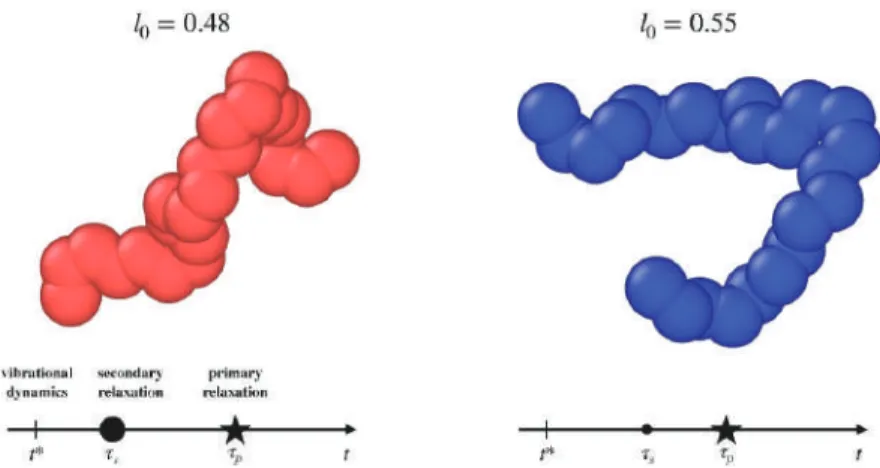
Preparation and Characterization of UV-LED Curable Acrylic Films Containing Biochar and/or Multiwalled
All the filled UV-LED cured films show a good dispersion of the two carbonaceous film substances. The presence of this phenomenon can probably be attributed to the speed of the UV-LED curing process, which freezes the macromolecules in a non-equilibrium thermodynamic state. Then, all the UV-LED cured films were analyzed through thermogravimetric (TG) analysis performed in nitrogen and air to investigate the effect of the carbon-based fillers on thermal and.
Finally, the simultaneous presence of the two carbon fillers was affected by the different morphology of biochar and MWCNTs in UV-LED-cured EB150. UV-LED curing performed in the dynamic configuration allowed achieving complete double bond conversion, even in the presence of higher filler loadings.
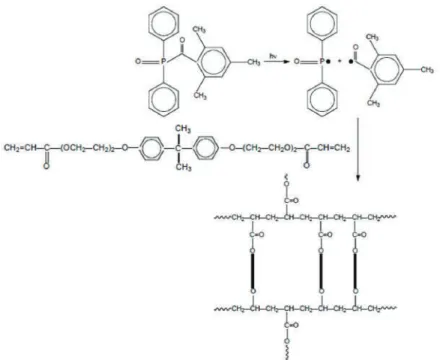
Electrically-Conductive Polyketone Nanocomposites Based on Reduced Graphene Oxide
Experimental 1. Materials and Methods
The reaction between stoichiometric amounts of Gly-Gly and 2,5-hexadione was carried out in a 100 ml round-bottomed vessel equipped with a magnetic stirrer, a reflux condenser and a Heat-On™ Block system (Radleys Shire Hill, Saffron Walden , Essex, United Kingdom). Functionalization of PK30 with Gly-Gly was performed to achieve 30% conversion of polyketone di-carbonyl groups (Table 1). rGO/PK30-Gly-Gly composites were prepared by mixing PK30-Gly-Gly and lrGO or hrGO at different weight concentrations (wt.
First, PK30-Gly-Gly was dissolved in a round-bottom flask containing 20 mL of chloroform under vigorous stirring at 50 °C for 20 min. After cooling to room temperature, the solvent was removed and the obtained rGO/PK30-Gly-Gly composite was completely dried at 40 °C for 24 hours.

Result and Discussion
The wavelength of the excitation laser was 542 nm, and the laser power was below 1 mW without noticeable heating of the sample. The microscopic morphology of the composite samples was observed by scanning electron microscopy using a Dual Beam FIB/SEM Helios Nano-Lab 600i (Thermo Fisher Scientific, Hillsboro, OR, USA), 10 kV accelerating voltage and variable magnification. Electrical measurements of lrGo and hrGO solid dispersions were performed according to literature reports [50,51].
Temperature-dependent resistance measurements were performed on square samples of 6 mm × 6 mm thickness 1.05 mm connected by two copper electrodes to the opposite edge of the square: temperature control was achieved by placing the sample on a thin ceramic plate substrate ( 0.3 mm ), equipped with a gold resistor (on the lower side not in direct contact with the sample), connected to the controlled power supply module. Measurements were performed by modulating the temperature by changing the current applied to the ceramic heater and waiting for the temperature to stabilize.
DYHQXPEHUFP A
Moreover, thermogravimetric analysis (TGA, Figure S2) proved a different degradation behavior of the two types of rGO as well as a distinct residual mass. Conversely, the disorder-induced D band at around 1340 cm−1 is attributed to the scattering of defects that break the basic symmetry of the graphene sheet [54,55]. The large contribution at around 2900 cm−1 is possibly attributed to the combination of the first overtone of the D band (2D band) and D+G band.
Aliquots (100 μl) of rGO chloroform dispersions were drop-cast onto gold-plated electrodes supported on a Kapton® film and the electrical resistance was measured after the complete evaporation of the solvent. Figure 4 shows the T rise for the lrGO/PK30-Gly-Gly composites as a function of filler concentration.
LOOHUSHUFHQWDJHZW
Scanning Electron Microscopy (SEM) photomicrographs at different magnifications of the nanocomposite composed by PK30-Gly-Gly and lrGO at different weight percentages. To evaluate the effect of different degrees of reduction in the rGO filler, we tested samples containing 5 and 6 wt. Nevertheless, these values appeared markedly lower than those measured from the corresponding lrGO/PK30-Gly-Gly composites, consistent with the more reduced rGO content in the hrGO sample.
In addition, the composites showed a marked reduction in resistivity after 50◦C, which can be related to the Tg of the same composites (Figure 4). This indicates that above the Tg, the polymeric matrix allows increased mobility of the rGO flakes, achieving a transient network where the electrons can flow through the material [62].

7HPSHUDWXUH&
In Figure 9, we show the resistance variation of the lrGO/PK30-Gly-Gly composite during five heating and cooling cycles from 30 to 115◦C. Overall, we observed that the resistance of the materials was reliably restored over each cycle. We also easily modulated the electrical resistance of the composite by increasing the concentration of rGO in the mixing process.
Heating and cooling cycles showed that the conductive network is preserved, indicating a high stability of the rGO dispersion in the polymeric matrix. The effect of the polyketone aromatic pendant groups on the electrical conductivity of the derived MWCNTs-based nanocomposites.
